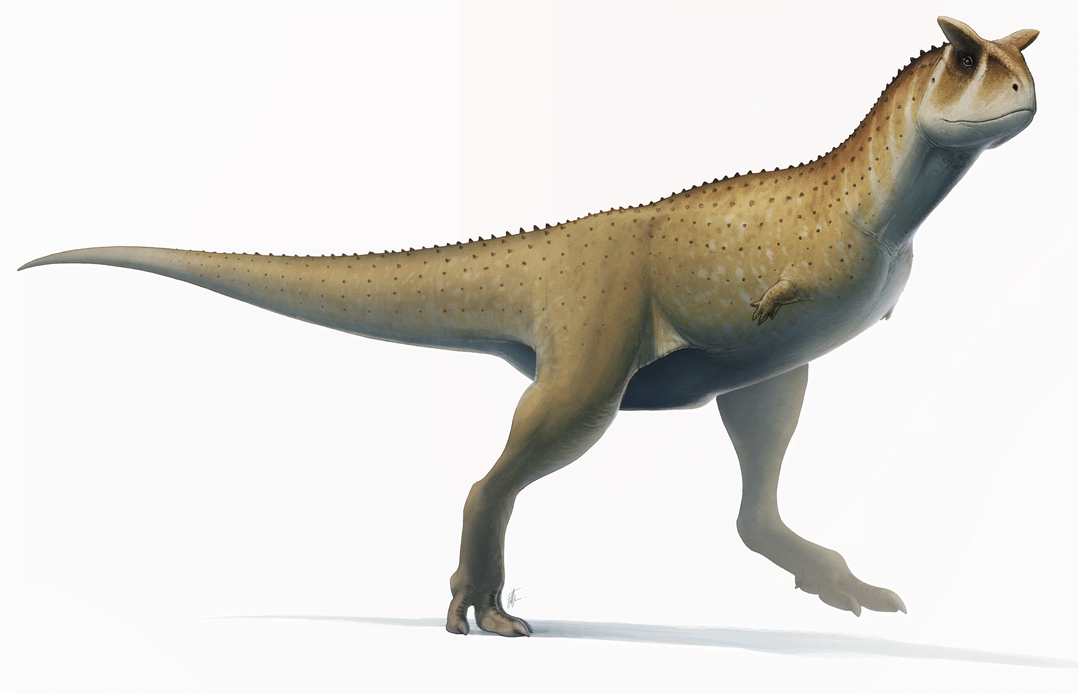Dinosaur, Carnotaurus, the Plains Stalker
Carnotaurus sprints with terrifying speed, its tiny horns and crushing jaws turning momentum into slaughter.
Carnotaurus is an unmistakable predator: a bipedal, deep-chested beast of sinew and bone built for explosive speed. Its body is sleek and muscular, with a narrow waist, long hind limbs, and a whip-like tail held stiff for balance. Most striking are the stubby, conical horns that rise from above its eyes—more ornamental than practical—and its grotesquely reduced forelimbs, barely more than clawless stumps. Its skin is scaled and leathery, sometimes mottled in reds, ochres, or dark greys to blend into dry brush or savanna shadows.
Behaviour
Carnotaurus is a solitary ambush predator known for bursts of blinding speed and deadly precision. It avoids unnecessary conflict, preferring calculated, surgical strikes to drawn-out chases. Although aggressive when cornered, it relies on stealth and terrain to maximize its chances. It is a territorial animal, but less overtly territorial than others of its kind—conflict with others is rare and usually resolved with display posturing rather than violence.
Habitat
Carnotaurus favors open plains, dry forests, and rocky scrublands—environments that offer both cover and room to charge. It avoids densely wooded areas where its speed is limited. Often, its presence in a region is known only by the absence of other large predators. Signs of its passage include twisted carcasses, circular ambush trails, and deep, three-toed footprints near watering holes.
Modus Operandi
A patient stalker, Carnotaurus will observe herds or patrol routes for days before striking. Once it selects a target—typically the young, sick, or straggling—it uses blinding speed to close the distance and strike with crushing jaws, designed not for slashing but for deep, puncturing bites that cripple prey. Unlike some theropods, Carnotaurus does not grapple or drag; it kills quickly and consumes fast, wary of scavengers or rival hunters.
In combat, Carnotaurus uses sudden movement, flanking behavior, and terrain advantage. Its tail allows tight turning and balance, enabling it to chase prey through winding canyons or across uneven ground with surprising agility.
Motivation
Carnotaurus is motivated by pure survival instinct. It hunts to feed, patrols to remain unchallenged, and displays aggression only when threatened or starved. While not needlessly cruel, it is utterly merciless—a natural-born killer honed by an unforgiving world. To Carnotaurus, anything smaller and slower is either a threat to be removed or food to be consumed.
Carnotaurus 5e
Carnotaurus, Pathfinder
Carnotaurus
Large Beast, Unaligned
Challenge Rating: 7 (2,900 XP) • Proficiency Bonus: +3
Armor Class 15 (natural armor)
Hit Points 123 (13d10 + 52)
Speed 50 ft.
| STR | DEX | CON | INT | WIS | CHA |
|---|---|---|---|---|---|
| 20 (+5) | 18 (+4) | 18 (+4) | 2 (–4) | 14 (+2) | 8 (–1) |
Saving Throws
Dexterity +7, Constitution +7, Wisdom +5
Skills
Perception +5, Stealth +7
Damage Resistances
Bludgeoning, Piercing, and Slashing from Nonmagical Attacks while Charging
Senses
Darkvision 60 ft., Passive Perception 15
Languages —
Traits
Predatory Speed
The Carnotaurus can Dash as a bonus action. When it uses Dash in the same turn it moves at least 20 feet in a straight line, its next melee weapon attack gains advantage.
Ambush Predator
In the first round of combat, the Carnotaurus has advantage on attack rolls against any creature that hasn’t taken a turn.
Unnerving Display
When the Carnotaurus is first spotted or emerges from hiding, it can use a bonus action to flare its head, stomp the ground, and emit a low bellow. Each creature of its choice within 30 feet that can see or hear it must succeed on a DC 15 Wisdom saving throw or have disadvantage on attack rolls against the Carnotaurus until the end of its next turn.
Actions
Multiattack
The Carnotaurus makes two attacks: one with its Bite and one with Tail Slam, if available.
Bite
Melee Weapon Attack: +8 to hit, reach 5 ft., one target
Hit: 24 (3d10 + 5) piercing damage.
If the target is a creature, it must succeed on a DC 15 Strength saving throw or be knocked prone.
Tail Slam
Melee Weapon Attack: +8 to hit, reach 10 ft., one target
Hit: 17 (2d10 + 5) bludgeoning damage.
If the target is prone, this attack deals an additional 9 (2d8) damage.
Momentum Charge (Recharge 5–6)
The Carnotaurus moves up to its speed in a straight line. It can move through creatures one size smaller than itself during this movement.
Each creature in its path must succeed on a DC 16 Dexterity saving throw or take 22 (4d8 + 4) bludgeoning damage and be knocked prone. The Carnotaurus may then make a Bite attack as a bonus action against one prone target in reach.
Tactics
- Opening Round: Emerges from cover using Ambush Predator and Unnerving Display to sow panic and soften up frontliners.
- Round 2: Uses Momentum Charge to scatter or knock down a line of enemies, then bites a prone target.
- Tactical Retreat: If bloodied (reduced to half HP), it may Dash to retreat to high ground or cover, drawing attackers into a bottleneck for counterattacks.
- Mob Control: Combines Bite and Tail Slam to knock enemies prone and punish them while downed.
Environment
Open plains, dry woodlands, scrublands, canyon edges.
Often solitary, hunting in wide, silent loops before striking.
Treasure
Carnotaurus doesn’t collect treasure, but trophies like teeth or bones may be worth 50–200 gp to scholars, alchemists, or monster hunters. Its hide may be crafted into boots or armor that grant temporary speed boosts or improved balance.

Illustration of CarnotaurusFred Wierum
This slender biped stands tall on long, clawed legs, and its arms have atrophied into little more than nubs. Its short, deep skull is crowned with two small horns and its jaw is filled with serrated teeth. Its body is covered with tubercles and scales.
The carnivorous dinosaurs combine bone-breaking strength with remarkable speed. They are thin and leggy creatures built for sprinting. Rather than tackle similarly sized megafauna, they specialize on small game— “smaller” includes creatures of human size. They prefer to strike with speed, snatching a lone target in their jaws, gulping it down in a single motion, then retreating from possible retaliation.
Carnotauruses are typically solitary creatures, but gather in large numbers to display and mate. Although both male and female carnotauruses have horns and rugose skulls, those of the males are thicker and are used in ritual shoving matches to establish breeding hierarchies. Carnotauruses are not above cannibalism, and ritual combat sometimes gives way to fights to the death if a combatant shows signs of weakness or ill health. A carnotaurus grows to about 30 feet long and weighs about 3,000 pounds.
Carnotaurus CR 6
XP 2,400
N Huge animal
Init +8; Senses low-light vision, Perception +21, scent
Defense
AC 19, touch 14, flat-footed 15(-2 size, +4 Dex, +1 Dodge, +6 natural)
hp 71 (11d8+22)
Fort +9, Ref +11, Will +6
Offense
Speed 50 ft.
Melee bite +13 (2d8+14 plus grab/19-20)
Space 15 ft.; Reach 15 ft.
Special Attacks devastating bite, sprint, swallow whole (Medium, 1d8+8 bludgeoning, AC 13, 9 hp)
Statistics
Str 25, Dex 18, Con 15, Int 2, Wis13, Cha 8
Base Atk +8; CMB +17 (+21 grapple); CMD 32
Feats Dodge, Improved Critical (bite), Iron Will, Power Attack, Skill Focus (Perception), Vital Strike
Skills Perception +21
Ecology
Environment warm plains
Organization solitary, pair or lek (3-18)
Treasure none
Special Abilities
Devastating Bite (Ex) A carnotaurus deals twice its Strength modifier as bonus damage to its bite attack.
Sprint (Ex) Once per hour, a carnotaurus can move up to 10 times its normal speed (500 ft.) when making a charge or run action.
Carnotaurus as Animal Companions
Starting Statistics: Size Medium; Speed 50 ft..; AC +1 natural armor; Attack bite (1d8); Ability Scores Str 15, Dex 21, Con 8, Int 2, Wis 13, Cha 12; Special Qualities low-light vision, scent, sprint.
4th-Level Advancement: Size Large; AC +3; Attack bite (2d6); Ability Scores Str +4, Dex -2, Con +4; Special Attacks devastating bite, grab, swallow whole (Small)

 Buy me a coffee
Buy me a coffee